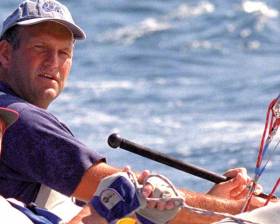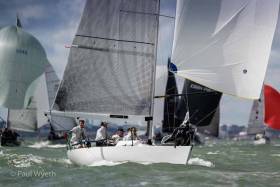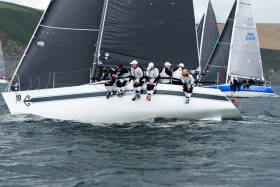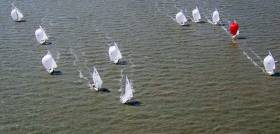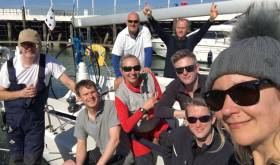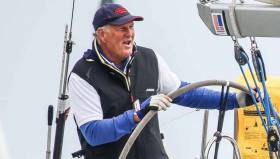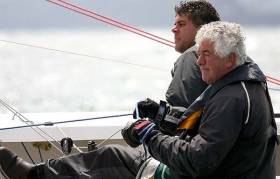Displaying items by tag: Mark Mansfield
Mark Mansfield, 'Force of Nature' in Irish & International Sailing
Mark Mansfied of Cork has been a major presence in Irish and international sailing for decades. With his considerable height and presence, and air of being intensely focused on the task in hand, he is at the core of any sailing crew and campaign with which he becomes involved, all with his usual 100% dedication. W M Nixon catches up with a continuing stellar sailing career as Mansfield’s renowned expertise in rig tuning and sail optimisation sees an extra aspect added to his life with racing boats.
Mark “Mono” Mansfield is a Force of Nature. It could not be otherwise. Of impressive height (6ft 5ins), and with an intensely and intelligently focused look to his face when the topic is of interest to him, the fact that he is at his most alive when racing a sailing boat defines his life.
As for his considerable presence, many of us can remember when, at a very youthful age, he was effectively the skipper of Turkish Delight, the “big boat” of the Irish Admirals Cup team of 1987. The boat was welcomed into the squad to comply with the required size range for the three boat team, and she came complete with a colourful and decidedly characterful Turkish owner who was determined to be part of the action, and could have dominated the on-board setup.
 Mark Mansfield, aged 37 in 1999. He had sailed his first Admirals Cup aged 19 in 1981, and skippered his first Admirals Cup boat in 1985. Photo Robert Bateman
Mark Mansfield, aged 37 in 1999. He had sailed his first Admirals Cup aged 19 in 1981, and skippered his first Admirals Cup boat in 1985. Photo Robert Bateman
But Mansfied – youthful and all as he was, being barely 25 – was well able to keep up his end of the deal for Ireland . And as much of the preliminary action had a strong Cork flavour, with wives, mothers and girfriends keeping an eye on developments as only the Cork sailing women can, I found myself talking to his mother about how Mark’s sailing ability and power of personality were far beyond what you’d expect of someone of his age.
“He has always been like that” she said. “As an infant he was of course a large baby, he developed very fast, and by the time he was eight months, it was all we could do to keep him in his cot. He’d haul himself upright by hanging onto the rails, and dominate the entire household just by sheer power of will, personality and determination. Looking back, I think that childhood cot was his first boat…..”
In the Cork way, Mark’s first boat was a present from his Godfather. It was a well-used International Cadet, but as his Godfather happened to be Harold Cudmore Senr, that Cadet had originally belonged to Harold Cudmore Jnr, one of the very first boats of his internationally stellar career.
But the problem with being Mark Mansfield was that he was always a big lad. He outgrew junior dinghies almost as soon as he’d acquired them, and so he felt more comfortable on larger craft, and soon was Number One man to his father Stafford Manfield, a classic Cork sailor who steadily worked his way up through boat sizes until in the 1970s he was the first owner of the Rob Holland-designed, Cork-built 30ft Club Shamrock Demelza, a winner in a very keen class.
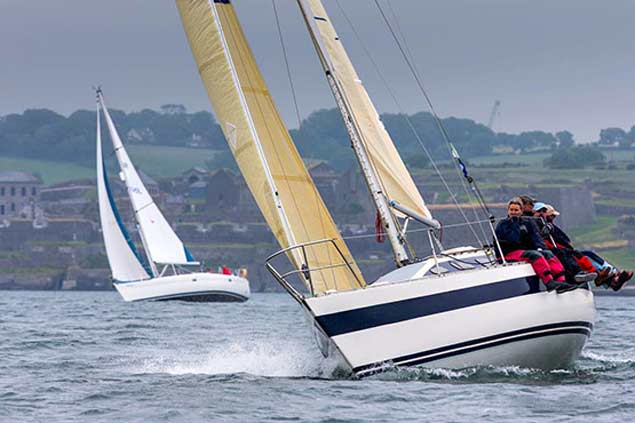 The Club Shamrock Demelza’s first owners were Stafford Mansfield and his son Mark. Now owned by Steph Ennis and Windsor Laudan, the 40-yearold Demelza continues to win races, and is seen here doing so at the Sovereigns Cup in Kinsale
The Club Shamrock Demelza’s first owners were Stafford Mansfield and his son Mark. Now owned by Steph Ennis and Windsor Laudan, the 40-yearold Demelza continues to win races, and is seen here doing so at the Sovereigns Cup in Kinsale
This made the Mansfields – for the father and son sailed on equal terms – the first of a succession of successful Demelza owners. In time, to acquire the db2 Luv Is, they sold the boat on to Neville Maguire of Howth, who won both the Irish Sea Championship and his class in the Round Ireland race with her, as well as many inshore championships. Then Neville in turn sold her to Steph Ennis and Windsor Laudan, who continue Demelza’s winning ways, even with the boat now hovering around 40 years of age.
But being part of Irish sailing history, through Demelza and other noted craft, is only of very incidental interest to Mark Mansfield today. His focus is on the current challenge, and the ones after that. He may be 55, but he lives in the present and looks to the future with a refreshing intensity, and this has been the hallmark of his entire sailing career.
Thus, even as he was increasingly involved in his father’s keelboat sailing with the balance of on-board command inevitably moving in Mark’s favour, for two or three years he was Mirror Dinghy racing in Cork Harbour despite being almost immediately too large for the boat.
But then the Laser made her debut in Ireland in the early 1970s, and this was the ideal boat for his already considerable (and athletic) size on the cusp of his teens. There were few enough topline Crosshaven sailors in Lasers in those early days before Mark had the freedom of his own driving licence, but somehow he got himself to major events and found his skills being sharpened by the Irish elite, a Who’s Who of subsequent stars in many sailing areas, with Gordon Maguire at their peak.
By this stage, the young Mark Mansfield was so totally immersed in sailing in so many different boats that academic pursuits took second place – or indeed no place at all – unless they were academic pursuits with a boat racing element, in which case they were given the total attention of a fiercely concentrated and considerable intelligence. But it wasn’t a formula for academic success in the orthodox sense, so after leaving school, college was set aside and he got a job in one of the main banks which, in those more easygoing times in the workplace, could be arranged to maximize serious sailing time.
It may have been “serious sailing time”, yet when Mark Mansfield is undertaking serious sailing with a crew who match his own enthusiasm, he is at his happiest, different indeed from the brooding and sometimes sharp-tongued presence which can manifest itself when he feels someone is not up to the job, or worse still, not giving of their best.
But then, his sailing career in his most formative years could only turn out someone like this. When he and his father moved on to the all-conquering db2 Luv Is, they set standards in inshore and offshore racing which few other boats could match, winning more trophies and major championships than he can quickly recall.
 “Men in White” – the new Moonduster’s crew in distinctive gear at her debut in 1981. Youngest crewmember was the 19-year-old Mark Mansfield. He was occasionally given the helm and found a special interest in the sails and rig
“Men in White” – the new Moonduster’s crew in distinctive gear at her debut in 1981. Youngest crewmember was the 19-year-old Mark Mansfield. He was occasionally given the helm and found a special interest in the sails and rig
In that era, in 1981 he was also one of the “Men in White” aboard Denis Doyle’s new Crosshaven-built Frers 51 Moonduster, a total Crosshaven product as all the sails came from the McWilliam loft just up the road. By this stage, in addition to his skippering and helming skills, Mark Mansfield found himself increasingly absorbed by the special demands of rig-tuning and sail shape, and thus he found himself at age 19 – the youngest in the Moonduster crew – with an interest which has developed over the years until now it is central to his sailing.
He didn’t totally move out of dinghies, as the early 1980s also saw him with an already well-used 505 which was certainly enough of a boat to be a really satisfying challenge for him. But even though he qualified for the 505 Worlds in Australia, it was a woefully under-funded campaign – a learning experience in itself – and it was little short of miraculous that they finished half way up an very competitive fleet.
Back home, he married Alethea in 1984, and they have two daughters, but sailing soon came centre stage again for Mark, and he was helm/skipper for Ireland in the 1985, 1987 and 1989 Admirals Cup, as well as hitting the big time international glamour with helming roles in the 1986 and 1988 Sardinia Cups.
For their own boat, after many successes with the db2 Luv Is, he and his father secured an X-Yachts Agency for Ireland, and this brought them the X-372 X-Cavator, which Mark raced with success in the 1988 Round Ireland race, and in which he perfected the famed “Mansfield controlled broach”.
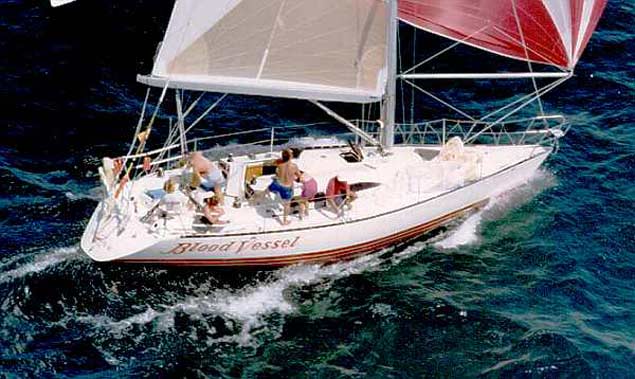 An X-372 of the 1980s. With a sister-ship in the Round Ireland Race (though not in weather like this), Mark Mansfield perfected the art of the “controlled-flat-down-broach” to slither over mile-long salmon drift nets
An X-372 of the 1980s. With a sister-ship in the Round Ireland Race (though not in weather like this), Mark Mansfield perfected the art of the “controlled-flat-down-broach” to slither over mile-long salmon drift nets
In those distant days, parts of the Round Ireland Course were crossed by many almost-invisible salmon drift nets, some of them a mile long, and they were a special menace for fin and skeg boats.
Spending time finding your way round them could lose you the race, but in heavy spinnaker running approaching northwest Donegal – where the nets were thickest - Mark worked out a cunning plan. He went straight at the net flat out, and then in the last three or even less seconds, he threw X-Cavator into a spectacular broach which carried her sideways, right over on her ear with the rudder out of the water, clean over the net.
“If you saw this coming up” quips Mark, “it was good manners to to tell the crew below what was about to happen….”
The 1990s and the early 2000s saw his sailing take in extra areas while continuing with those in which he was already established.
The Olympic Star called, a challenging and often brutal boat to sail, and he was selected as Ireland’s Olympic Star Class helm four times – in 1992, 1996, 2000 and 2004.
 “A mighty monster to sail”. The Olympic Star had a mainsail larger than many Half Tonners, but with only half the mainsheet tackle. Mark Mansfield and David O’Brien show that racing a Star is not for the faint-hearted
“A mighty monster to sail”. The Olympic Star had a mainsail larger than many Half Tonners, but with only half the mainsheet tackle. Mark Mansfield and David O’Brien show that racing a Star is not for the faint-hearted
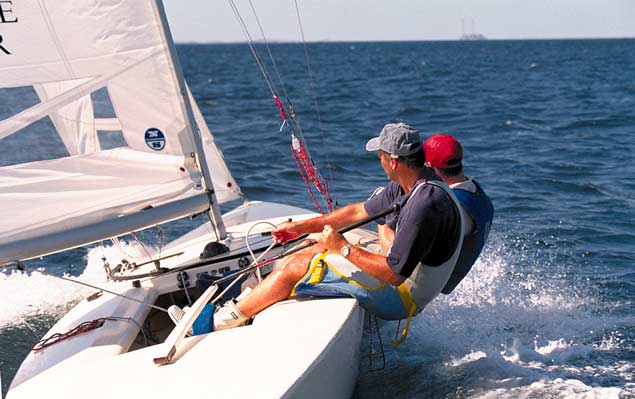 Mark Mansfield sailing the Olympic Star. “A monument to discomfort, an ergonomic disaster zone….” – yet people loved them, and still do
Mark Mansfield sailing the Olympic Star. “A monument to discomfort, an ergonomic disaster zone….” – yet people loved them, and still do
The shortage of resources to see the campaign right through to the end at peak performance told in the Olympic results, for although he managed a 3rd, 5th and 8th in the Star Worlds, and won the Star Europeans in 2004, an Olympic Medal eluded him.
In fact, during this period – when he also found time to be overall winner of the 1997 Spi Ouest Regatta in France - the boat you feel he was happiest with was the 1994 Crosshaven-developed 1720. These days, it’s difficult to remember the excitement this then-novel Sportstboat class developed at home and abroad. Entries for the World Championships – particularly if they were held at Crosshaven or Kinsale - pushed towards the hundred level, and Mark won the Euros in 1998, 1999, 2010 and 2011.
 God be with the days…..in the late 1990s, the 1720 Sportsboat class could muster nearly a hundred boats at their Euros at Crosshaven or Kinsale Photo: Robert Bateman
God be with the days…..in the late 1990s, the 1720 Sportsboat class could muster nearly a hundred boats at their Euros at Crosshaven or Kinsale Photo: Robert Bateman
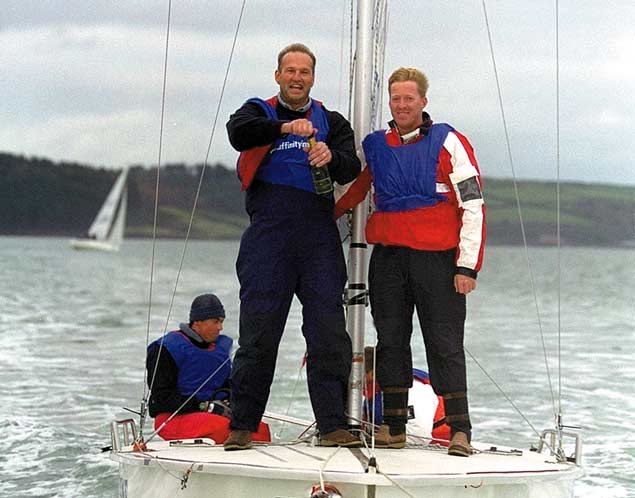 Mark Mansfield and James Hynes about to celebrate after winning the All Ireland Sailing title. Photo: Robert Bateman
Mark Mansfield and James Hynes about to celebrate after winning the All Ireland Sailing title. Photo: Robert Bateman
As the 21st Century progressed, honours descended on a sailor who was ever more diverse in his involvements afloat. Such was the demand to race other people’s boats that it has made sense to downsize his own personal boat to a handy 6 Metre RIB, but he was and is sailing more than ever, and became Ireland’s Sailor of the Year twice, and also twice won the All-Ireland Helmsman’s Championship.
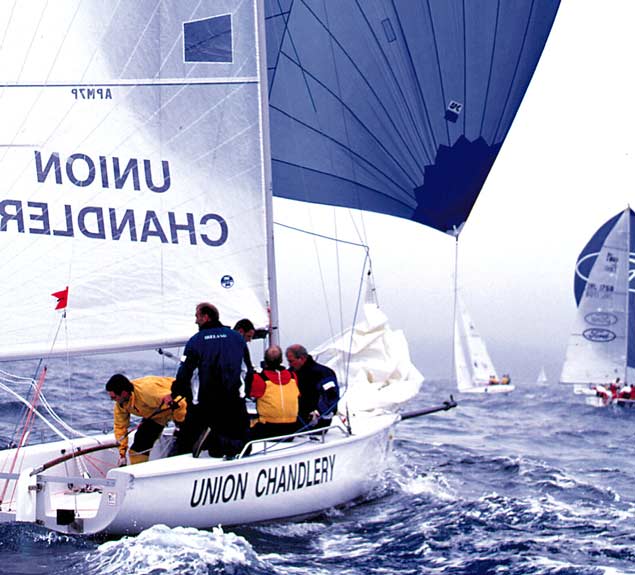 Mark Mansfield revelling in the racing in the 1720s class in their prime. Photo: Robert Bateman
Mark Mansfield revelling in the racing in the 1720s class in their prime. Photo: Robert Bateman
Although still sailing very much as an amateur, he brought the highest professional levels to so many campaigns that he can count no less than five overall wins in Cork Week, wins too at the Scottish Series and the British IRC Nationals with Conor Phelan’s 2006-built Ker 36 Jump Juice, and Commodore’s Cup success as well.
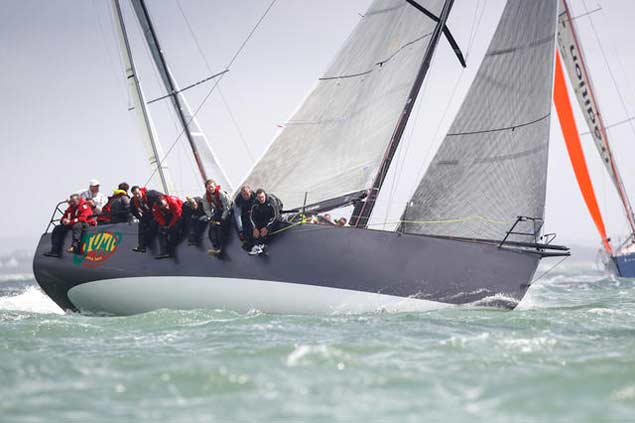 Conor Phelan’s Ker 36 Jump Juice, on her way to winning the British IRC Championship, Mark Mansfield at stern in white cap Photo: RORC
Conor Phelan’s Ker 36 Jump Juice, on her way to winning the British IRC Championship, Mark Mansfield at stern in white cap Photo: RORC
So what’s it like to crew with such a powerhouse of sailing success? Sources with extensive experience of the Mono Mansfield phenomenon have put it pithily:
“He's a percentages sailor and conservative. He’s never a man to go out hard on either side of a first beat. Instead, he plays the fleet well to make sure he has leverage on the bulk of them. Consequently, he might not be first round a weather mark, but you can count on him in big fleets to be consistently in the top ten race after race.
Technically, very quick to set up rigs and understand sail shape and what makes a boat go quick.
A super steerer – he can really get the most out of a boat, sometimes by feel of the rudder alone.
A formidable animal when the breeze is up, but he also cuts it across the wind range
Doesn't suffer fools or crews ('trained monkeys') gladly.
Huge ability to concentrate for long periods, to a level which could be called hyper-focus".
Three years ago, Dublin Bay J/109 owner John Maybury asked Maurice “Prof” O’Connell of North Sails if he knew of someone who could sail with him and his crew to beef up their performance. The Prof suggested Mark Mansfield, and so began a remarkable relationship in which the Cork star was willing to travel the long road to Dublin many times in order to be given carte blanche to bring Joker 2 and her crew up to their full potential.
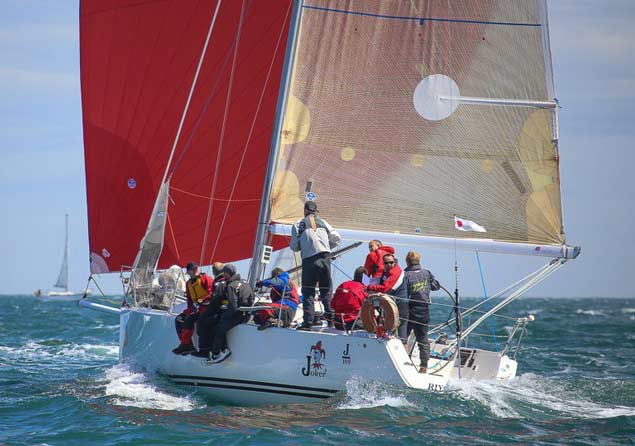 John Maybury’s J/109 Joker 2, which Mark Mansfield has assisted to conspicuous and consistent success Photo: Afloat.ie
John Maybury’s J/109 Joker 2, which Mark Mansfield has assisted to conspicuous and consistent success Photo: Afloat.ie
A good boat was made into a great boat. Joker 2 with Mark Mansfield on board has been a stellar J/109 for those three years, with top honours in many areas. But after a year or so, Mark’s personal circumstances changed. After working for several years in a major mainline bank in Cork, and rising in the management ranks, twenty years ago he was offered the position of manager of the Cork office of one of the leading Dublin-based Building Societies.
It was a demanding role, and being Cork, there was a strong personal element to it. Not everyone could have stayed the course, but Mark did. However, after twenty years of it, following on his time already spent in the mainline bank, he felt he had done his duty and more by the financial services sector. There was the option of taking early retirement at the age of 55, and he’d been developing interesting ideas about how he might spend the remainder of his working life. The opportunity of taking that early retirement at 55 was too good to resist.
So at much more than twice the age at which most sailors go professional, Mark Mansfield quietly let it be known that he is now a fulltime sailor.
It proved to be a remarkably painless transition process. All the owners with whom he sailed knew that he already brought a level of commitment which was away ahead of many known professionals. Seen in the context of the overall cost of keeping a frontline boat in full contender condition, a fee for Mark Mansfield’s presence was only a small part of the overall budget, and extremely good value.
It was with John Maybury and Joker 2 that the new arrangement was first tested last year. In terms of the mood on board and success achieved, nothing fundamental had changed at an operational level. If anything, as John comments, while Mark was even more intense and concentrated during racing, he was more relaxed otherwise. After all, following a weekend’s racing in Dublin Bay, he was no longer facing the prospect of a long Sunday night drive home to Cork knowing that Monday would bring another morning of misery in the office.
So as far as sailing is concerned, Mark is as good and concentrated at it as ever, but is more relaxed when the day’s racing is done. For sure, he now has people to talk to who may be interested in using his services, but that old boyish enthusiasm has never left him, as Dave Cullen discovered when he set up the Euro Car Parks Challenge in the Volvo Round Ireland Race 2016 with the chartering of the Kelly family’s J/109 Storm.
He really did hit the jackpot, as he got both Mark Mansfield and Prof O’Connell in his crew. But at the halfway stage of the race, it looked as if Paul O’Higgins’ new JPK 10.80 Rockabill VI - likewise racing with a rockstar crew – had the class all stitched up.
But Euro Car Parks crew really did sail like pros. They simply never gave up. Any setbacks for Rockabill VI, and they were ready to pounce. And pounce they did, though it was murderous hanging on to their newly-acquired and slender handicap lead coming down the Irish Sea to become the only Irish class winner in the entire race.
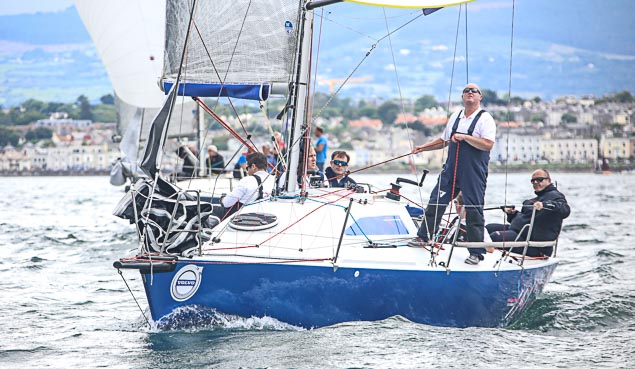 Dave Cullen of Howth Yacht Club (pictured here on the tiller of Checkmate) sought Mark Mansfield for his 2016 Round Ireland campaign
Dave Cullen of Howth Yacht Club (pictured here on the tiller of Checkmate) sought Mark Mansfield for his 2016 Round Ireland campaign
Dave Cullen was so inspired by the vivid memories that, late on Thursday night this week, he leapt to the keyboard to give us the definitive picture of Mark Mansfield:
“Once I decided to embark on a Round Ireland Race campaign after an 18 year gap, and had identified the J/109 as a contender if it was to be a light airs race, next task was to assemble the best crew possible.
Without even thinking about it, my next phone call was to Mark “Mono” Mansfield. It was a natural decision having watched him conjure some fantastic results up on other J/109s, and watching him in action at the previous ICRAs in Kinsale, as he started before our class.
Immediately, Mark was really interested and having gotten ground clearance from the home office, all systems were go. Given the closeness of the ICRA Nationals at Howth and his busy schedule, his first sail with us on Euro Car Parks was out towards the start line in Wicklow.
Many will have heard Mark bellow his way around a race course from other boats, but quite the opposite was the case with us. Even putting us OCS at the start didn’t faze him, and we quickly settled into a pattern very comfortably as Mark rapidly displayed his huge skills in eking extra speed out of our J/109.
 The big man on the wheel. Mark Mansfield on the helm of the J/109 Euro Car Parks (Dave Cullen) at the start of the Volvo Round Ireland Race 2016, in which she was the only Irish class winner. Photo Afloat.ie
The big man on the wheel. Mark Mansfield on the helm of the J/109 Euro Car Parks (Dave Cullen) at the start of the Volvo Round Ireland Race 2016, in which she was the only Irish class winner. Photo Afloat.ie
Day Two turned out to be a horror show weather-wise, and Mark remained calm and positive as we pounded our way along the South Coast, taking miles out of our opposition. Mark’s imposing stature was at its most obvious when four of us jammed into the aft double cabin off watch, but nobody minded too much.
I have known Mark for many years and remember our first sail together on Infinity in Calves Week, when I was a little intimidated by his fearsome reputation. That soon dispersed when we had pre-race pints in Newman’s of Schull, and I realised what a fun guy lies behind that cool exterior.
What is most noticeable about Mark is that he is at his happiest when at sea. Our five days bashing around Ireland were what can be described as just good craic with Mark, where he mixed steely determination, great care for those less experienced, and a nice mix of fun and slagging.
It nearly feels as though Mark is uncomfortable ashore, as if he yearns to cast off again as soon as possible. Having raced against Mark in 1720s and Half Tonners, and then adding in our Round Ireland campaign (where we won Class, and were first Irish boat), there is no doubt in my mind that he is one of Ireland’s most talented sailors ever to emerge.
Leaving professional sailing to his later years is perhaps a waste of such a talent. But love him or leave him, you cannot but respect this huge talent on the race course”.
Even at 55, were Mark Mansfield to base himself on the Solent, he could make a fortune. As it is, his professional visits there recently have brought success. But Ireland is his place and his stage, and Cork is his home. So he has been looking at ways of adding an extra income dimension to his new role as a full-time sailor.
The changeover at UK Sailmakers Ireland in Crosshaven has provided an opportunity, and Mark is now an agent for UK Sailmakers, fascinated by the access to their hyper-computerised sailmaking facility in the Hong Kong (the largest in the world), while they still retain a complete frontline service in Crosshaven.
 "Men in Black" – Mark Mansfield (left) and Graham Curran in the UK Sailmakers loft in Crosshaven
"Men in Black" – Mark Mansfield (left) and Graham Curran in the UK Sailmakers loft in Crosshaven
But while his first advice would be to use UK, he emphasises that he’s an agent, and not an employee. Thus his skills and status as a fulltime sailor, rigging specialist and rating expert can be accessed by boats kitted out by other sailmakers.
He is if anything keener than ever. And Monday morning is no longer something to be dreaded. This is the new Mark Mansfield. But if you’re thinking your boat’s performance could be much improved by having Mark Mansfield on board, you’d better get a move on. Paul O’Higgins has already signed him up on Rockabill VI for the Volvo Round Ireland Race 2018.
 Mark Mansfield seen recently at Howth in his new role. Having been racing the previous day in the Howth Autumn League, he has just given an hour’s interview for this blog, and is now about to go sailing with clients. Photo: W M Nixon
Mark Mansfield seen recently at Howth in his new role. Having been racing the previous day in the Howth Autumn League, he has just given an hour’s interview for this blog, and is now about to go sailing with clients. Photo: W M Nixon
Mark Mansfield is contactable on telephone: +353 87 250 6838
Quarter Ton Cup Review: Sam Laidlaw Sets New Marker for Success
Mark Mansfield, the recently appointed UK Sailmakers Ireland Racing Consultant, reviews last week's Quarter Ton Cup in Cowes in which he sailed as tactician on Ireland's fourth placed Anchor Challenge skippered by Paul Gibbons
This year's Coutts Quarter Ton Cup event was reduced to two days after the first day was blown out with gusts of close to 30 knots. But the two following days provided great sailing and very testing conditions in the Hill Head Plateau off Cowes, Isle of Wight. In the end, it was Sam Laidlaw's Aguila which was the deserving winner, with Ian Southworth's Whiskers taking second, Mark Richmond taking third on the Chartered Cote, and Paul Gibbons from Royal Cork Yacht Club taking fouth on Anchor Challenge. Paul's crew for the Event were all from Cork, myself, Mark Mansfield, Killian Collins, Joe Bruen and Grattan Roberts.
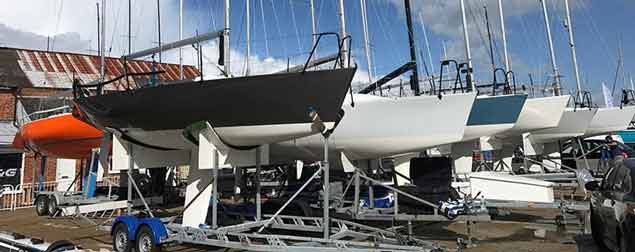 Ready for racing - the 23–boat fleet lined up in Cowes Yacht Haven included on Irish entry, Anchor Challenge from Cork
Ready for racing - the 23–boat fleet lined up in Cowes Yacht Haven included on Irish entry, Anchor Challenge from Cork
Aguila has been the form Quarter–Tonner this year and has won most of this year's events. They have tried a number of times to win this event, but failed in the past at the final hurdle, often to Louise Morton's Bullit. This year they left no stone unturned and prepared the Boat immaculately and spent up to ten weekends practicing and competing in Quarter Ton class events in Cowes in preparation for the Quarter Ton Cup. They were worthy winners and took all three races on the final day to win easily in the end. They did, however, have a disqualification due to a protest Lodged by Anchor Challenge for an on–the–water incident on day one and so had to be very careful not to have a bad race or an OCS as they had already used their discard.
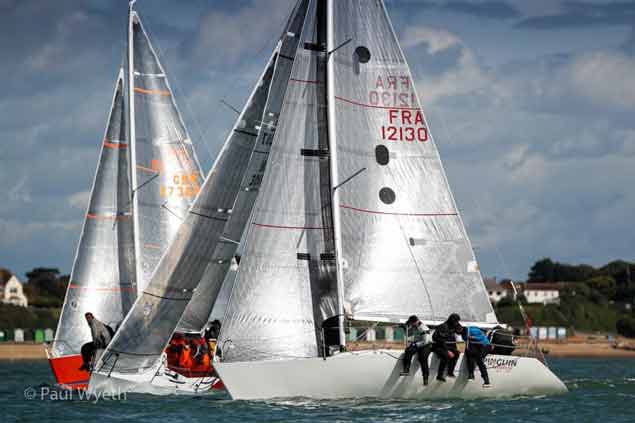 Close racing at the Cup Photo: Paul Wyeth
Close racing at the Cup Photo: Paul Wyeth
The first day of racing was cancelled so four races were scheduled and completed on day two in brisk 20 to 25 knot winds that witnessed some spectacular broaches. Two race wins from Ian Southworth's Whiskers took him to the top of the leaderboard, just ahead of the Paul Lees steered Black Fun, with the Mark Richmond steered Cote next and Anchor Challenge, with one race win, in fourth Place. Sam Laidlaw had dropped to fifth overall but counted a DSQ, which he would be looking to discard.
Day two had very different condition with a light seven knot breeze out of the Northwest. Four races were scheduled but this would always be an ask as the final race had to start by 14.30. Sam Laidlaw made no mistakes and from the off was the one to beat, finding very good speed in these lighter conditions. Ian Southworth tried to stay in contention and was only two points back going into the third race of the day. A tenth in that race scuppered his chances and with the wind dying and the 14.30 timelimit approaching the OOD, Rob Lamb, signaled an end to the Day and the Regatta. Paul Lees, 2nd going into the day overall had a 16th and a 14th to drop him to fifth overall. Cote had solid results as did Anchor Challenge.
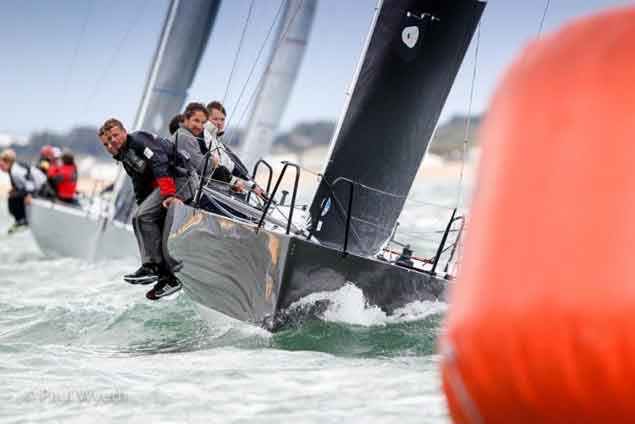 Mark Richmond's Cote approaching the windward mark on day two of the Coutts Quarter Ton Cup 2017 with Land Rover BAR sailor Nick Hutton on board as bowman Photo: Paul Wyeth
Mark Richmond's Cote approaching the windward mark on day two of the Coutts Quarter Ton Cup 2017 with Land Rover BAR sailor Nick Hutton on board as bowman Photo: Paul Wyeth
Anchor Challenge could possibly have taken a third overall as she had to divert behind a ship coming in the North Channel in race six which took her from third to tenth in that race and in the end she missed out on the podium by three points. She had very good speed in the breeze and was solid in the light and was definitely one of the fastest boats in the fleet. However the level of time put in by San Laidlaw seems to have taken him up a notch and he was the deserving winner this year.
Going into the event, other favourites were class President, Louise Morton's Bullit which had won the three previous Quarter Ton Cups, but unfortunately Louise did not find any form this year and had to contend with 10th overall, three places ahead of her husband Peter Morton on Innuendo who finished in 13th Position. Peter is the current Fast 40 One Ton Cup Champion on Girls on Film.
Boat Changes
3 newly updated Quarter tonners were in evidence this year, Oliver Orphaus has a beautifully prepared job done On Bullet, a Near Sistership to Buttit. Oliver finished in 9th Position. Tom Hill had John Corby prepare his Belinda and she was looking immaculate and clearly was one that everyone wanted to see do well. The stronger winds on Thursday were not to his liking but the boat performed very well in the lighter conditions to finish in 12th overall. Finally Barry Arts from Holland had the Beautiful Stephen Jones Designed Wings in immaculate condition, however he could not find much speed and finished down the fleet.
 Tom Hill's John Corby prepared Belinda Photo: Mark Mansfield
Tom Hill's John Corby prepared Belinda Photo: Mark Mansfield
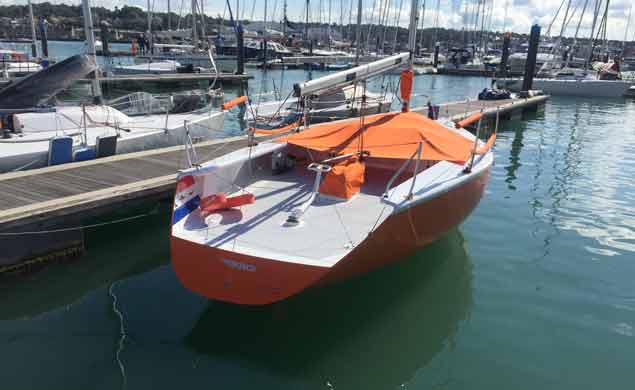 Barry Arts from Holland brought the Beautiful Stephen Jones Designed Wings to Cowes Photo: Mark Mansfield
Barry Arts from Holland brought the Beautiful Stephen Jones Designed Wings to Cowes Photo: Mark Mansfield
Competition
Clearly the event is going from strength to strength with 23 entries and nearly all of these are now fully restored with new rigs and new keels. Of the 23 competitors, 16 had at least one professional and some had up to four pros on board. The class has an owner driver rule with no limit on professionals. Some eyebrows were raised when a driver in the fleet was allowed to compete who was not an owner and in the past such applications had been declined. Going forward the class will need to keep an eye on the way this rule is observed if it wants to attract owner–drivers.
So how do Quarter Tons compare to Half Tons?
Having finished fourth in this year's Half Ton Cup with Michael and Richard Evans, The Big Picture, it is easy to see that the Quarter Ton class is still more competitive than the Half Ton class, but not by much, and the gap is closing. The Quarter Ton class favours no limit on professionals whereas the Half Ton class is likely going to set a limit on professionals.
I would say there are likely more Quarter Tonners that can win races whereas in the Half Ton Class, it is only about six at the moment at the top level. The Quarter Tonners behave more like a dinghy whereas the Half Tonners are more cruiser like. This can be seen downwind where the top Quarter Tonners will reach much higher speeds in a breeze than the Half Tonners.
Much of this is due to the weight of the boat with the Halfs having inboard diesel engines, whereas the Quarters only have small outboards. The rigs would be set up similarly in each case, though most Quarter–Tonners have just one set of spreaders, whereas the Half–Tonners have two sets of spreaders, requiring a bit more care in the set up.
The sails are quite similar except that the Quarter Ton rigs are much more flexible and so the rigs on these need to be adjusted all the time. Extra turns on the forestay and upper and lower shrouds in the breeze to straighten the forestay while still allowing a decent amount of backstay to be used before the mainsail runs out of luff round and no further backstay can be used.
 Tuning and calibration on the White family's Joker
Tuning and calibration on the White family's Joker
The Half Tonners, with their stiffer masts allow a lot of backstay use and rarely run out of luff–round.
Next year, The Quarter Ton Cup will return to its normal June slot and up to four events are planned in advance of this June event, to allow competitors to prepare for the event. Clearly Sam Laidlaw has set a marker on what level of time and preparation is needed if you want to win the Quarter Ton Cup.
Mark Mansfield is a four time Olympian in the Star Class and a Racing Consultant with UK Sailmakers Ireland
Four Time Olympian Mark Mansfield Joins UK Sailmakers Ireland
The new owners of Cork Harbour based UK Sailmakers Ireland have appointed Mark Mansfield as an agent and racing consultant to their Crosshaven loft.
Mansfield is a Royal Cork Yacht Club stalwart at the top end of sailing for many years — this season serving as tactician on a number of leading Irish keelboat campaigns, including a third consecutive win at the ICRA National Championships on the J109 Joker 2 that also won Boat of the Week at Dun Laoghaire Regatta.
Recently retired from his career in banking, Mansfield has been looking for a new business direction that puts his passion for sailing first.
And he feels that representing the quality product line of UK Sailmakers Ireland is a perfect fit.
“They have always had a strong reputation in Ireland and worldwide for many years and offer a very viable alternative — and with the new owners, will be priced very competitively,” Mansfield says.
He emphasises the quality product and backup, competitive prices and expertise in sail and rig set-ups that will make UK Sailmakers Ireland a new force in sail packages — and the number-one choice for your boat.
When it comes to his own credentials, Mansfield’s renown in the speed arena is in no doubt. A four-time Olympian (in Barcelona, Atlanta, Sydney and Athens) in the Star keelboat, Mansfield also notched a win in the Star Euros and a third place in the Star Worlds. He has also won National and Euro honours in Royal Cork's own 1720 sportsboat class.
In 2005 he returned to big boats, which he had previously helmed in the 1980s to a series of Admiral’s Cups, when he took the helm of the unforgettable Jump Juice in the Commodore’s Cup.
Switching to Sailing Class One in more recent years, Mansfield had found his calling as a title-winning tactician on boats such as Joker 2, Big Picture (Half Tonner) and Anchor Challenge (Quarter Tonner), as well as being a middleman in the Etchells and Dragon class.
He's also produced results offshore winning in class in the 2016 Round Ireland Race.
In these roles, Mansfield has built a solid reputation for his expertise in fast sail shapes and rig tuning. A move into sailmaking is therefore a natural progression — and a shrewd investment for UK Sailmakers Ireland continued growth.
Mansfield will be lending his strategic talents to the marketing of UK Sailmakers’ Titanium package, which has already proven popular internationally. Expect to see more of these on the Irish sailing scene in the coming years, especially with Mansfield involved.
UK Sailmakers Ireland was founded as McWilliam Sailmakers in Crosshaven in 1974 by noted dinghy and offshore racing champion John McWilliam and his wife Diana. Four years later they were joined by John’s brother Des and his wife Sue, who took over the business in 1993.
In 1996 McWilliam Sailmakers joined the Ulmer Kolius group’s network of UK Sailmakers lofts, rebranding as UK/McWilliam. In 2011 Des McWilliam was elected president of UK Sailmakers, succeeding the group’s founder Butch Ulmer.
This past summer Des McWilliam and his wife Sue announced their retirement at the end of this year, as well as the sale of their business to Barry Hayes, who started his sailmaking career with the McWilliam family; Hayes’ wife Claire Morgan; and Graham Curran, who currently works in the Crosshaven loft.
UK Sailmakers Ireland contacts:
Mark Mansfield ([email protected])
Claire Morgan ([email protected])
Graham Curran ([email protected])
Barry Hayes ([email protected])
Reviewing Half–Ton Sailing: The Classic Cup in Kinsale & a Sailors Poll to Decide the Future
Mark Mansfield, tactician on The Big Picture, fourth overall at August's Euro Car Parks Half Ton Classic Cup 2017, reviews progress in the Class and the Kinsale Yacht Club event.
Having done the last two versions of this event I feel I have a decent level of knowledge to comment on the racing and the classes progression. Firstly well done to the organisers for staging a great event at Kinsale Yacht Club and well done to the Principal Race Officer Anthony O'Leary for running it so well. Finally, well done to Phil Plumtree and the Swuzzlebubble team for winning the regatta with a race to spare. This is the third win for Swuzzlebubble in three events, each with a different owner. More about this later.
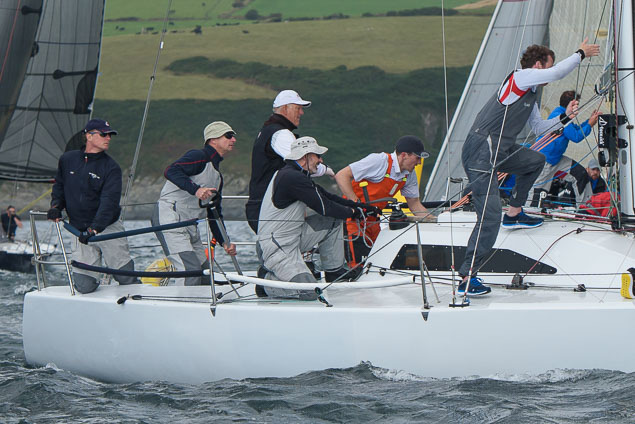 Mike and Richie Evans's The Big Picture, from Howth Yacht Club was fourth overall. Tactician and article author Mark Mansfield is wearing the white cap Photo: Bob Bateman
Mike and Richie Evans's The Big Picture, from Howth Yacht Club was fourth overall. Tactician and article author Mark Mansfield is wearing the white cap Photo: Bob Bateman
Day One—Nigel Biggs' new Checkmate XV111 just led from Paul Pullen's Miss Whiplash on countback. Swuzzlebubble lay one point back and Mike and Richie Evans,The Big Picture, lay a further point behind. David Cullen's Checkmate XV was a few points further back and it seemed likely that these five boats would be the feature boats in the event. All had professional sailors aboard and one of these boats had three professional sailors. Swuzzlebubble had an eighth place on this day which she would eventually discard but it was clear that she would be the one to watch as she was the top rating boat by some margin and was using that extra speed to get out in front allowing her to sail her own race.
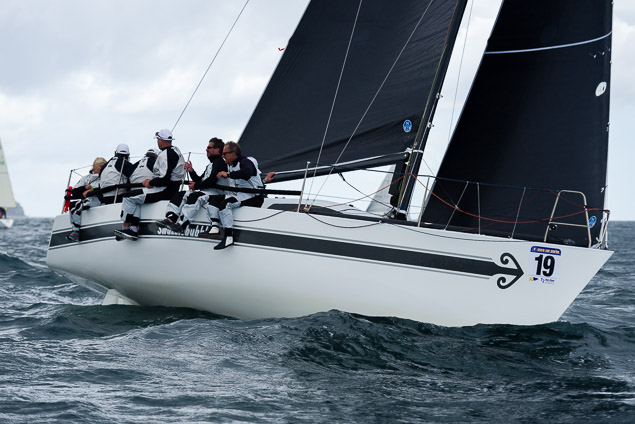 Phil Plumtree's Swuzzlebubble had an eighth place on day one but it was clear that she would be the one to watch as she was the top rating boat by some margin Photo: Bob Bateman
Phil Plumtree's Swuzzlebubble had an eighth place on day one but it was clear that she would be the one to watch as she was the top rating boat by some margin Photo: Bob Bateman
Day Two—Strong Southerly winds were forecasted for the following few days and so the organisers took the decision to delay the coastal race until later in the week and use day two to get in as many short WL races as possible. In the end four good races were sailed in moderate to fresh testing conditions. Swuzzlebubble counted two wins and two second places to shoot into a large lead over David Cullen's Checkmate who also scored two firsts. One point back was Checkmate XVIII and The Big Picture lay in fourth, a few points back. Big loser of the Day was Paul Pullen's Miss Whiplash who had four very average results and fell out of the running. It was now clear that the first four boats (Swuzzlebubble, Checkmate XV, Checkmate XVIII and the Big Picture) were pulling well clear of the pack and the winner would be from this group. Occasionally, other boats such as Paul Wayte's beautiful newly optimised Headhunter, Johnny Swan's Harmony and Philippe Pilatte's General Tapioca would come to the fore, but it was the first four that generally filled the top three results in each race and were pulling well clear.
 Paul Pullen's Miss Whiplash had four very average results on day two and fell out of the running Photo: Bob Bateman
Paul Pullen's Miss Whiplash had four very average results on day two and fell out of the running Photo: Bob Bateman
Day Three—Wednesday was postponed due to excess wind and many enjoyed a long lunch in Kinsale's Fishy Fishy restaurant accompanied by some very nice wines.
Day Four—Strong Southerly winds greeted the competitors and three races were planned including the none–discard coastal race. Swuzzlebubble took a first and a second in the earlier Windward Leeward races to extend her lead and the two closest followers, the two Checkmates each counted a poorish race to allow Swuzzlebubble be on the cusp of winning the regatta outright if she had a decent last coastal race. The Big Picture had consistent top results to lie in fourth. The final race of the day, the coastal race, ended in Swuzzlebubble taking a fifth, though a relatively poor result for her, it was enough to ensure Swuzzlebubble could not now be caught and did not need to sail the final race on the Friday. 1.5 points now separated the Two Checkmates with Dave Cullen in the marginal lead. Big Picture finished the Coastal race in second place and lay in fourth overall and could neither fall to fifth in the last race on Friday, nor get up to third. There was then a large points gap to General Tapioca and Headhunter.
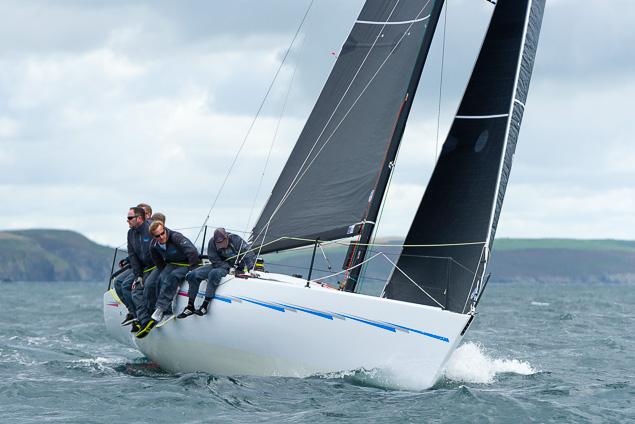 Only 1.5 points separated the two Checkmates with Dave Cullen's Checkmate XV (below) in the marginal lead. Photos Bob Bateman
Only 1.5 points separated the two Checkmates with Dave Cullen's Checkmate XV (below) in the marginal lead. Photos Bob Bateman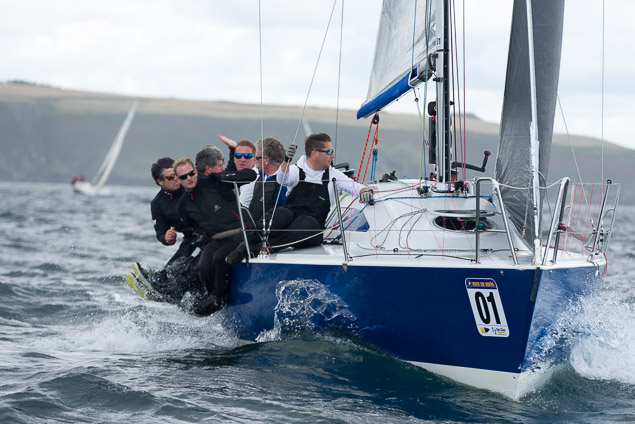
A successful Class dinner was held in Actons Hotel on Thursday night which went on late into the night, for some.
Day Five—Swuzzlebubble decided not to sail on the Friday. First and fourth places were already finalised (Swuzzlebubble and The Big Picture). Nigel Biggs needed to finish ahead of Dave Cullen and have a boat between them to finish in second overall. 17 to 20 knots greeted the fleet and PRO O'Leary signalled an around the buoys race consisting of two rounds and a finish off Charles Fort in Kinsale. Nigel Biggs got the best of the start and was ahead most of the race. However, Dave Cullen was in a bunch close behind that included the Big Picture. By the last mark Nigel Biggs rounded in the lead, followed by three other boats flowed by Big Picture with Checkmate XV behind her. Big Picture pulled through to second and Checkmate XV to third across the line. Big Picture with her lower handicap had a chance to snatch the win and deny Checkmate XVIII second overall but fell short by nine seconds and so the race finished with Checkmate XVIII winning followed by The Big Picture, followed by Checkmate XV, thus giving second overall to Nigel Biggs and Third overall to David Cullen. Fourth overall went to the Big Picture, fifth to General Tapioca and sixth to Miss Whiplash.
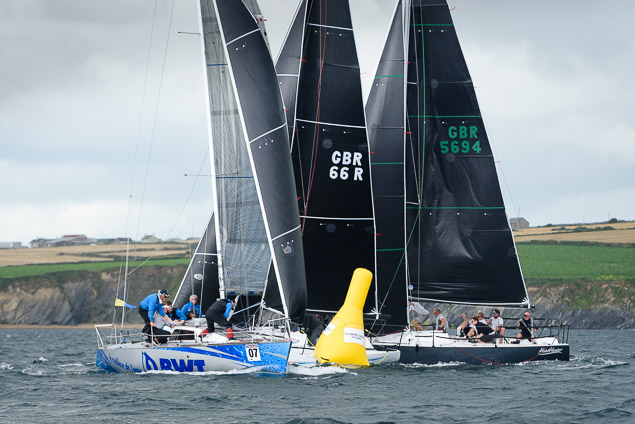 Half Ton racing is excellent, very close. The camaraderie within the class is also very strong
Half Ton racing is excellent, very close. The camaraderie within the class is also very strong
Progression of the class – Three newly optimised boats were among the 21 entries this year. The larger fleets of Half–Tonners are based in France, the UK and Belgium and if the event were in one of these locations it is likely entries would be closer to 30. During the regatta an agm was held to discuss some important points that appear to be affecting the class. These were;
1 Should the class limit the number of professionals on each boat
2 Should the class, like they do in the Quarter ton Class, put an upper handicap limit on yachts taking part.
3 Should the class allow asymmetrical spinnakers.
1—Limiting professionals. A poll of Half Ton members will likely be done to either limit the professionals on each boat to either one or Two. It was felt generally that professionals help to coach the crew and generally are good for the class, but too many and the professionals can effectively sail the boat themselves, thus little improvement happens when the pros depart.
2—Limiting the upper Handicap limit. Swuzzlebubble has been a problem child in this class since Peter Morton did a no–expenses spared restoration of this very long half tonner. This included a taller, ultra high Modulus Carbon Rig with more sail, a deeper keel and other top mods. This led to her being approx. 25–points higher rating than most. Consequently she can go for a conservative start, sail for a few minutes and then her speed allows her to cross the fleet and sail the remainder of the race without other interference. The remainder of the fleet are close on rating and end up very close to each other at all marks, taking wind on downwinds, etc. This is costing the bulk of the fleet a minute or more per race, and often that is about the margin that Swuzzlebubble wins by. She is being well sailed, but she has a great advantage. In the Quarter ton class they stopped this issue early and now most quarter tonners are within 10 points of rating of each other. It is being suggested that an upper limit of .965 be introduced. Swuzzlebubble would be able to get to this by reducing sail area and adding some weight which would lessen the advantage she currently enjoys, especially in light to medium conditions. A proposed poll of the class is being organised on this.
3—Allowing Asymmetric sails. This appeared not to be so straight forward. Some owners already have them (but can't use them at the Half Ton Cup). Allowing them might mean owners have to buy one or two asymmetric kites, perhaps add a sprit and in the end may not even use them at a Half Ton cup. Others would prefer to stay without them as most of the racing is windward leeward anyway. This will also be balloted.
Summary – Having sailed four Quarter Ton Cups and now two Half Ton cups, The Half Ton class is now easily as competitive as the quarter tonners. The racing is excellent, very close. The camaraderie within the class is very strong. I can see more restorations being done in this class and numbers rising for their Half Ton Cups. Next years event will be in Nieuwpoort in Belgium in mid–August and I suspect that there may be up to 30–boats will arrive for that. The inaugural IRC World Championships is being held just up the road in The Hague in Holland a month before the Half Ton worlds so there are many half–tonners considering doing that as well as a warm up event. The boats are of a size that they can, if required, be transported by water, though most will trail behind jeeps.
Mark Mansfield is a four–time Irish Olympian, a helmsman in the Star Class from 1992–2004. He is a World Sailing 'Group 3' Sailor.
Royal Cork's Mansfield Third in Cowes Week Etchells Class
Another top result for Royal Cork's Mark Mansfield in the Etchells Class this week as he took a podium in Cowes Week, racing as tactician,with Robert Drake.
Counting three race wins in the 7 race series they finished with a final race win on Saturday. Robert Elliott won the regatta with four race wins, with Stuart Childerley, three times Etchells World Champion, as tactician.
This one design fleet result comes hot on the heels of two other good one design results very recently for Mansfield. As Afloat.ie previously reported here, the four time Olympian was tactician on John Smart's J109 Jukebox which won the Tattinger J109 regatta in Yarmouth and taking a top–ten result as tactician with Mike Budd in the Dragon Edinburgh Cup.
As also reported previously, Mansfield also won the ICRA class one championships for the third consecutive time last June as tactician on John Maybury's Joker 2, and then went on to win the highly competitive Class 1 event on Joker 2 at Dun Laoghaire Regatta in July. This win also won Joker Two, the regatta's boat of the week prize.
Next up for Mansfield is a 'chill–out week' at Calves Week in Schull, West Cork this week followed by the Half Ton Classics Regatta in Kinsale next Sunday as tactician aboard Mike and Richie Evans Big Picture from Howth Yacht Club.
Royal St. George's Martin Byrne, fresh from British South Coast victory last week, is in the hunt for the Dragon Edinburgh Cup 2017 after two well sailed opening races for the sole Dublin Bay boat yesterday. Byrne is in ninth place in the 38–boat fleet. Cork interest in the regatta is focussed on Mark Mansfield's middle man role on Mike Budd's fifth placed entry. Download results below.
The International Dragon fleet is famed for the exceptionally close nature of its racing, but even in the Dragons a three-way tie for the overall lead of a regatta is truly extraordinary. But that is exactly the situation the top three boats have found themselves in.
Following two wet and windy races in the Central Solent, reigning Dragon World Champions Andy Beadsworth, Simon Fry and Ali Tezdicker sailing TUR1212 Provezza Dragon, five time Edinburgh Cup Champion Poul Richard Hoj-Jensen sailing GBR813 Danish Blue with Hamish McKay and Paul Blowers, and Martin Payne sailing GBR585 Full Speed with Chris Britten and Gillian Hamilton, are all tied for the overall lead on six points.
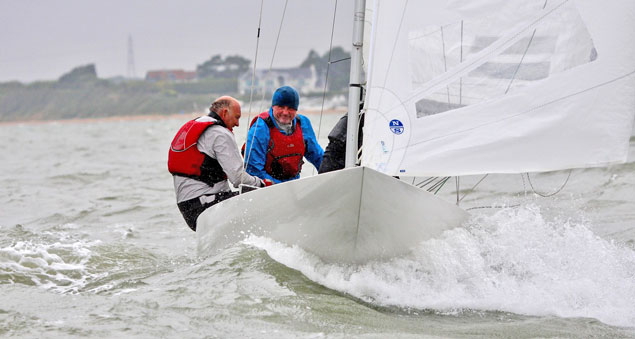 Royal Cork's Mark Mansfield (left) competing with Mike Budd and Mark Greaves are fifth. Photo: Fiona Brown
Royal Cork's Mark Mansfield (left) competing with Mike Budd and Mark Greaves are fifth. Photo: Fiona Brown
Hosted by the Island Sailing Club, this 69th edition of the prestigious Edinburgh Cup has attracted 38 entries from Russia, Turkey, Switzerland, Germany, Ireland and across the UK, for four days of windward leeward competition. The opening day of racing brought grey skies, a brisk south westerly wind ranging from 12 to 25 knots and a lot of rain. But, whilst conditions might not have been pretty, the racing was absolutely outstanding.
Race one produced a tight four boat tussle between Danish Blue, Full Speed, Graham Bailey's GBR782 Aimee, crewed by Julia Bailey, Will Heritage and Will Bedford, and Oliver Morgan's GBR791 Christianna, crewed by Francesca Morgan and Jamie Lea. On the line the four boats were separated by just 30 seconds with Aimee first, Christianna second, Full Speed third and Danish Blue fourth. A minute behind the leaders and just in front of the pack came Provezza Dragon in fifth, who'd correctly gone right early on the first beat, but then found themselves caught in heavy traffic from another fleet, which cost them dearly.
After their problems in race one, the crew of Provezza Dragon dug deep for race two, sailing a perfect first beat to lead by a comfortable margin at the weather mark. With the advantage of clear air, they were able to extend their lead throughout the race, winning by two seconds shy of a minute. In second was Danish Blue with Full Speed third and Ireland's Martyn Byrne sailing IRL216 Jaguar with son Conor and Pedro Andrade fourth.
In the overall standings the leading trio of Provezza Dragon, Danish Blue and Full Speed, who are all on six points, are followed by fourth place Aimee on eight points, Mike Budd sailing GBR793 Harry with Mark Mansfield and Mark Greaves is in fifth on fourteen points and Christianna sixth on 15 points.
Aimee also now leads the Corinthian competition for all amateur crews, with Owen Pay, Mark Daly and Jon Mortimer sailing GBR777 Furious third and Richard Leask, Willie Adams and Nevin Jaimeson, sailing GBR731 Kestra third.
Once back ashore and dried out, the competitors gathered for the daily prize giving, where not only did they were also invited to enjoy a relaxing head and back massage courtesy of Cowes based BeCalmed Wellbeing and Medi Spa. Caroline Hurley, owner of BeCalmed, present the daily prizes which included special gift baskets and bags from the company. Regatta Chairman Gavia Wilkinson-Cox then invited Race Officer Jill Smith to assist her with the daily draw into which all competitors are entered. Each evening three lucky winners receive one of more than £30,000 worth of prizes generously donated by local and marine companies. Later in the evening the visiting teams all attended "At Home" dinners hosted by members of the Cowes Dragon fleet.
The forecast for day two of the regatta promises to be much drier with lighter winds from the north. Two further races are planned with the first start scheduled for 11.00.
The two weekend Warsash Spring championship concluded last Sunday on the Solent with an overall win in the J109 class for John Smart's " Jukebox".
Tactician for the two weekends was Royal Cork's Mark Mansfield who has also raced with ICRA Boat of the Year winner, John Maybury's J109 Joker II.
Last weekend was curtailed by a lack of wind on the final day with no races sailed, so the series ended on eight races and one discard over the three days.
Jukebox had a solid series counting all top three finishes and being able to discard a fourth to take a four point win in the regatta. Full results here
Royal Cork's Mansfield Is Tactician on Winning J109 at Warsash Spring Championship Weekend
The first large regatta weekend of the year in the Solent is the Warsash Spring Championships weekend held over two weekends, the 8th and 9th of April and the 22nd and 23rd April.
Each weekend is Individually counted with an overall prize, plus an overall between result counting the two weekends.
Mark Mansfield, from Royal Cork, was calling tactics on John Smart's J109 Jukebox in the competitive J109 one design class. Five races were sailed in mainly 10–14 knot conditions and Jukebox ended with a 1,1,1,2,4 scoreline to take the first weekend by nine points over their next rival.
Mansfield has considerable J109 experience as he calls tactics on John Maybury's Joker II who is the 2016 ICRA Boat of the Year having regained her ICRA class one crown in 2016 previously won in 2015. He also sailed aboard David Cullen’s Euro Car Parks, also a J109, when she won her class in the 2016 Round Ireland Race.
More here
Ireland Represented At Etchells Worlds and Europeans in Cowes
Ireland will be well represented across the fleet at the Etchells European Championships that starts in Cowes today.
The Etchells 22 Class is, by many, regarded as one of the most competitive one design keelboat classes left now that there is no longer an Olympic Keelboat class.
The 2016 Worlds are scheduled for Cowes, Isle of Wight from the 5th to the 12th of Sept and will have 61 top level entries. Prior to that, in the same venue, will be the Etchells 22 European Championships, over today and tomorrow, which will is an unofficial warm–up event for the worlds.
Irish Interest in these events will be Malahide Yacht Club's Richard Burrows who is sailing Bedrock, with his daughter Samantha and local top sailor James Downer from Cowes. Royal Cork Yacht Club's Mark Mansfield, a four times Olympian in the Star Class, fresh from Success at the Irish IRC champs, Round Ireland Race, and European IRC Champs will sail as tactician on Andrew Coopers’ Ice. Mansfield has already Competed in the Quarter Ton Worlds in Cowes this year where he finished sixth and a fortnight ago won Cowes week in the Etchells 22 class aboard Coopers’ Ice.
Also racing in Cowes is Doris, skippered by Jay Bourke of Dun Laoghaire. Paddy Dillon (ex–Mermaid National Champion), Ruairi Grimes (third at recent J111 Worlds), Cathal Leigh Doyle (a former UCD Student Worlds Champion) and Morgan Reeser (American 470 Olympian married to 1996 Olympian Louise Cole) are also competing. Maurice O'Connell is coaching USA 1000 and USA 1404.
The Etchells Class is the choice of Many top Americas Cup and Olympic sailors and some top sailors competing this year include John Bertrand, Lawrie Smith, Steve Benjamin, Andy Beadsworth, Ante Razmiloviz, Chris Larson, Jud Smith, Jeff Madrigal, Luis Dopreste.
Reigning Champion is Skip Diebal from the USA and he will have his work cut out for him with such a competitive fleet, the majority of whom come from the USA, UK, Australia, and Hong Kong.
Half Tonners Hit The Spot for Irish Sailing
With the confirmation that Kinsale Yacht Club will be hosting the Half Ton Classic Worlds from August 14th to 18th 2017, Irish interest will intensify further in a class which already attracts much favourable attention. W M Nixon tells us more about a popular boat type which will have a defending champion from Ireland when the Worlds get under way in Falmouth in Cornwall in a week’s time.
If today’s newcomers to sailing find the resurrection of old offshore racing classes which are apparently only identified by specific weights a bit bewildering, then they can blame the first Commodore of the National Yacht Club in Dun Laoghaire.
The first Commodore of the NYC in 1931 was the Earl of Granard. The club had been founded in 1870 as the Kingstown Royal Harbour Boat Club, and in 1901 it became the Edward Yacht Club in honour of one of Queen Victoria’s many offspring. But with the new mood of the times after Irish Independence in 1922, such a name just wouldn’t do. Nevertheless it was a very sporting gesture when one of the landed aristocracy proposed the new no-nonsense name in 1930, giving it a fair wind by agreeing to be Commodore the following year.
Thus the big change to becoming “The National Yacht Club” was made respectable. But then, the Earl of Granard was a well-respected sailing man in his own right, despite the fact that his ancestral pile in County Longford was about as far from the sea as you can get in Ireland.
Admittedly there was sailing nearby with the North Shannon Yacht Club on Lough Forbes, which incidentally is named after the earl’s family – they were connected to the Forbes of the famous business magazine in America. However, despite the joys of sailing on Lough Forbes, the Earl had long been into bigger things on the international scene, though his interest still had an inland waterways aspect. In 1899 he’d presented a magnificent silver cup to the leading French sailing club, the Cercle de la Voile de Paris (CVP) for an international competition, to be sailed on the River Seine near Paris or on the Solent at Cowes, with the racing between boats which weighed one ton.
Although the trophy’s official name was the Coupe Internationale du Cercle de la Voile de Paris, it soon became known as the One Ton Cup, and continued to be so named even when racing was between yachts of the International 6 Metre Class, despite their weighing several tons apiece.
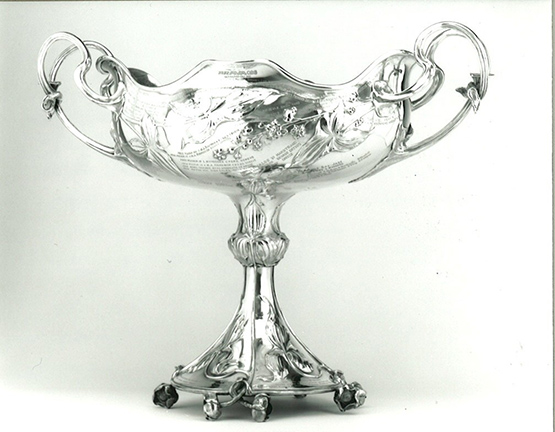 The cause of all the trouble – the One Ton Cup was presented to the CVP by the Earl of Granard, future Commodore of the National YC, in 1898, and was first raced for in 1899.
The cause of all the trouble – the One Ton Cup was presented to the CVP by the Earl of Granard, future Commodore of the National YC, in 1898, and was first raced for in 1899.
The magnificent cup remained as beautiful as ever, but with World War II it became almost forgotten until 1965, when the CVP proposed using it for an inshore-offshore international series for yachts rating at 22ft under the RORC rule, which worked out to be boats around the 36-37ft mark. The idea took off like a rocket - level-rating racing among diverse boats was an idea whose time had come. Very quickly, a whole range of additional international rating levels arose, with Two Tonners around 40-42ft, Three Quarter Tonners around 34ft, Half Tonners around 30ft, Quarter Tonners around 25ft, Mini-Tonners around 21ft, and they even had Micro-Tonners at about 18ft.
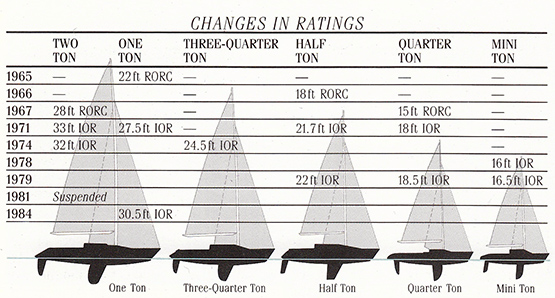 The Ton Classes at their peak
The Ton Classes at their peak
It all worked very well for twenty years and more in some cases (the last Half Tonner was built in 1992), with the boat sizes staying broadly the same size range, but with the ratings changed to accommodate the RORC rule being replaced by the IOR. And Irish sailing certainly had its moments in this continuing circus of various offshore racing acts. In 1974 the Ron Holland-designed, Cork–built 36ft Golden Apple somehow became more famous than the winner by being runner up the One Ton Worlds. But then in 1976, Harold Cudmore and a youthful crew from Cork put all questions aside by managing to get the new race-prepared Ron Holland-designed 30ft Silver Shamrock to Trieste for the Half Ton Worlds, and he won in style, famously celebrating by sailing up the Grand Canal in Venice with spinnaker set.
 The 1976 Half Ton World champion Silver Shamrock, getting an end-of-season lift-out at her current home port of Penzance in Cornwall
The 1976 Half Ton World champion Silver Shamrock, getting an end-of-season lift-out at her current home port of Penzance in Cornwall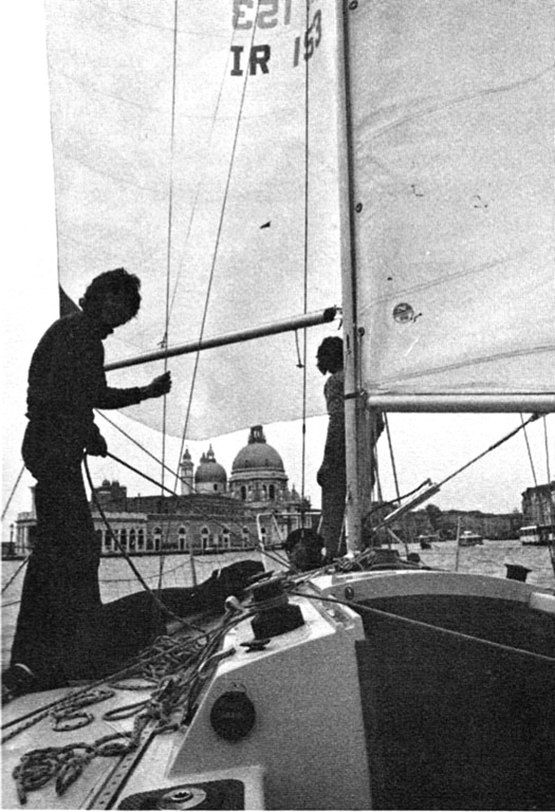 See the conquering heroes come…….Silver Shamrock sailing up the Grand Canal in Venice after winning the Half Ton Worlds 1976 in Trieste under Harold Cudmore’s command. Ronnie Dunphy on left, Killian Bushe on foredeck
See the conquering heroes come…….Silver Shamrock sailing up the Grand Canal in Venice after winning the Half Ton Worlds 1976 in Trieste under Harold Cudmore’s command. Ronnie Dunphy on left, Killian Bushe on foredeck
In 1981 he was back on top again, winning the One Ton Worlds at Crosshaven with the Castro-design Justine IV owned by Frank Woods (NYC). But by this time the boats involved were very different in form from those skinny-sterned designs which had dominated in the earlier 1970s, as a fresh wave of New Zealand designers like Bruce Farr and Laurie Davidson had been showing what could be achieved with broader sterns and better offwind performance.
The Half Ton Worlds was won in 1977, ’78 and ’79 by Kiwi boats of this type. But though she was not the overall winner, Ian Gibbs’ Farr-designed Swuzzlebubble was the one everyone remembered best, as she was on the podium one year as a centreboarder, and back there in the top three the year after, but this time as a keelboat.
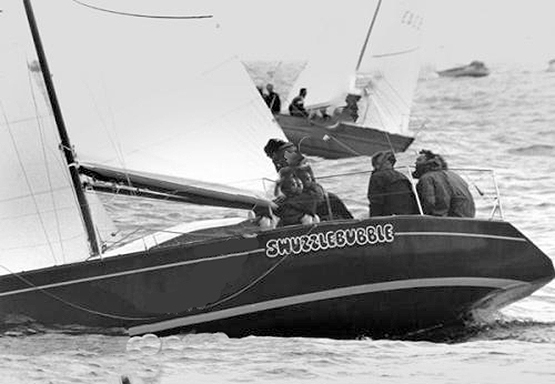 The new wave arrives from New Zealand – Swuzzlebubble in 1979
The new wave arrives from New Zealand – Swuzzlebubble in 1979
The following year she arrived in Ireland in the ownership of Bruce Lyster of Royal St George in Dun Laoghaire, and he won the ISORA Championship in 1980, plus ISORA Week and just about everything for which the boat was eligible in Cowes Week.
He had an exceptional crew of all the talents with Robert Dix, Drewry Pearson and Des Cummins, and Dixie remembers her as one of the most wonderful boats he ever sailed: “She found her own way to peak performance so effortlessly that you’d almost be scared to do anything which might adversely effect the trim” he quips.
He continues to say that even though Bruce Lyster sold Swuzzlebubble to Greece at season’s end, as you simply couldn’t improve on a season like they’d had in 1980. The Three Musketeers meanwhile transferred aboard Ken Rohan’s 40ft Regardless, with which they won their class big time in the 1981 Fastnet.
Regardless would be on most people’s short list for the greatest Irish racing yacht ever, yet Robert Dix remembers the previous season with Swuzzlebubble with even more enthusiasm. So it’s intriguing that at next week’s Henri Lloyd Half Ton Classics Worlds, the new wave of Irish Classic Half Ton sailors will be taking on Swuzzlebubble for the first time.
The story of her re-birth is typical of the modern revival of the very best of the old Ton Cup boats, with the One Ton Championship itself being revived for its Golden Jubilee in New Zealand in 2015 with a classic fleet. As for Swuzzlebubble, she was discovered in a very poor way indeed in a Greek boatyard in 2012, but was brought back to life by the King of Cowes, Peter Morton, who duly won the Half Ton Classics Worlds in Brittany in 2014 with her.
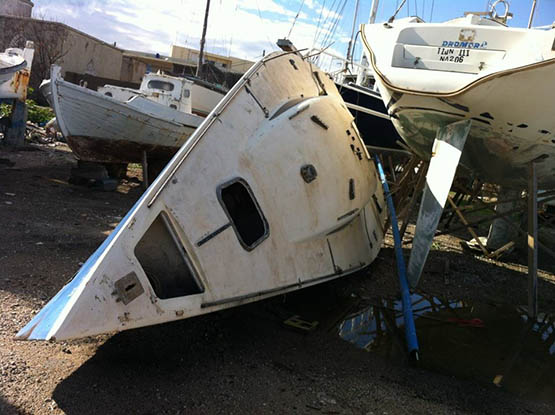 Next stop, the landfill site? Swuzzlebubble as she was found in Greece in 2012
Next stop, the landfill site? Swuzzlebubble as she was found in Greece in 2012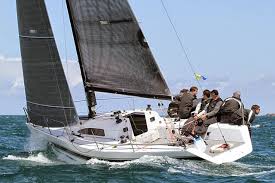 Swuzzlebubble restored, on her way to winning the Half Ton Classics in Brittany in 2014
Swuzzlebubble restored, on her way to winning the Half Ton Classics in Brittany in 2014
However, Swuzzlebubble wasn’t campaigned in the 2015 series in Belgium, when Dave Cullen took the trophy for Ireland with Checkmate XV. So there has been an air of unfinished business about these two rather special boats floating about the ocean without actually locking horns, but that’s all going to be changed in Falmouth.
 Dave Cullen on the helm as Checkmate XV makes a start to die for at the Half Ton Worlds in Belgium, 2015
Dave Cullen on the helm as Checkmate XV makes a start to die for at the Half Ton Worlds in Belgium, 2015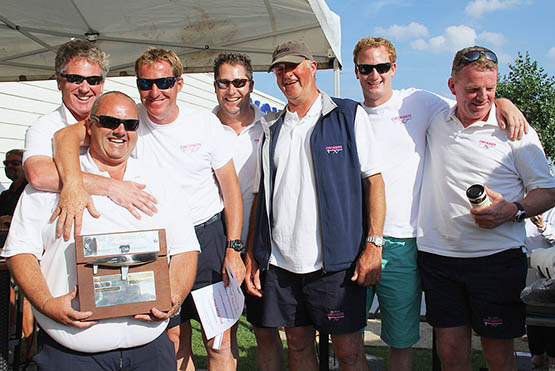 Winners take all – Dave Cullen and his crew with the trophy after victory last year
Winners take all – Dave Cullen and his crew with the trophy after victory last year
In fact, it has become Howth versus Falmouth, as Swuzzlebubble is now Falmouth-owned by Gregory Peck who, in a very varied sailing career, was one of the crew with Dickie Gomes aboard the 83ft catamaran Novanet when a new Round Ireland Record was established in November 1986, but that’s another story altogether.
However, in Falmouth there’ll be other boats involved too, as the word is they might muster as many as 30 entries, which is as big a fleet as anyone could reasonably wish for. The remarkable Howth/Fingal contingent will be there in full strength, as Checkmate XV will be taking the road with Jonny Swann’s Harmony, Michael and Richard Evans’ The Big Picture, and the David Kelly and Patrick Boardman team from Rush SC with King One, Half Ton World Champion in 1981.
It’s an intriguing mixture of nostalgia and modernity, as the boats get revamped to new ideas, yet they always carry their history lightly but definitely with them. In the case of the Howth boats, much of the technical work in revamping is done by ace boatbuilder Alan Power of Malahide, who appropriately is a powerboat nut himself, but his ability to think outside the usual boat-building box makes him the ideal man to undertake crazy notions for addicts of old but still potent offshore racers.
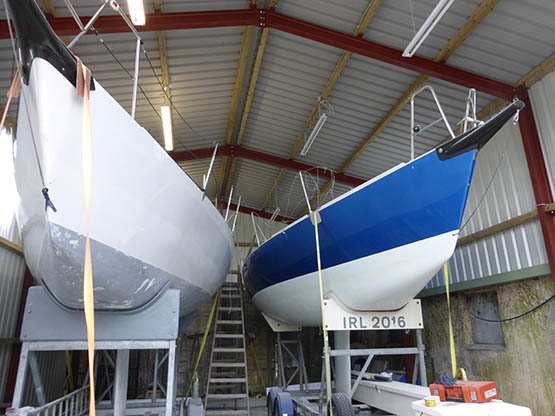
In line with this aim of maximising performance, the Howth/Fingal crewing lineup will include some formidable talent from all over Ireland, with Dave Cullen leading the charge with his 2015 crew of Johnny Murphy, Gary Cullen (no relation), Aidan Beggan, Mark Pettit, James Hynes and Andy George.
The crew on The Big Picture meanwhile have roped in Mark Mansfield of Cork, who is having a great year of it in a variety of boats, while the jockey for King One is young Marty O’Leary, one of the bright new talents to emerge in recent years from Courtown in County Wexford.
Down Falmouth way, it’s going to be Classic Half Ton Racing at its classic best. And if you wonder why it is that the Half Tonners seem to have been the most successful of all the Ton classes in reviving themselves after more than fifty years, perhaps the answer is that at 30ft they’re big enough as boats to be taken seriously, yet small enough to be a manageable proposition for keeping in top order and raced keenly.
 The contemporary Half Ton Classics lineup – the boats are big enough to be taken seriously, yet small enough to be manageable
The contemporary Half Ton Classics lineup – the boats are big enough to be taken seriously, yet small enough to be manageable



























